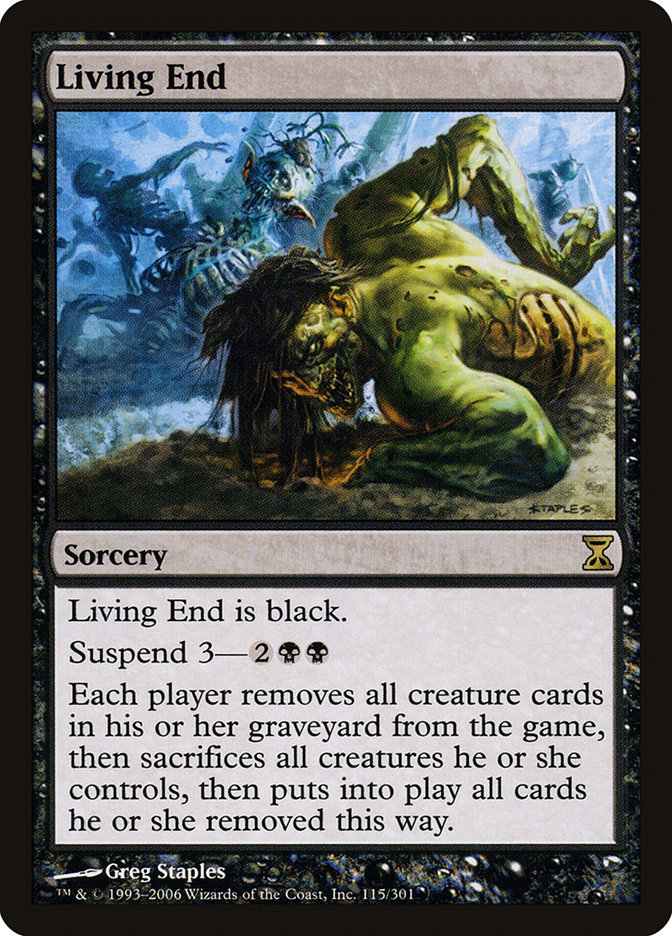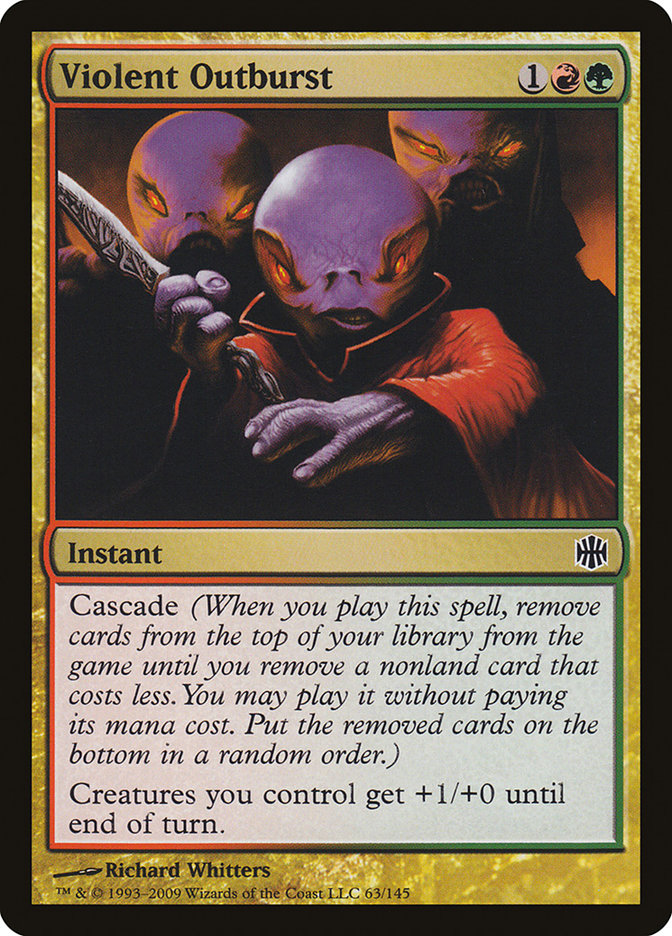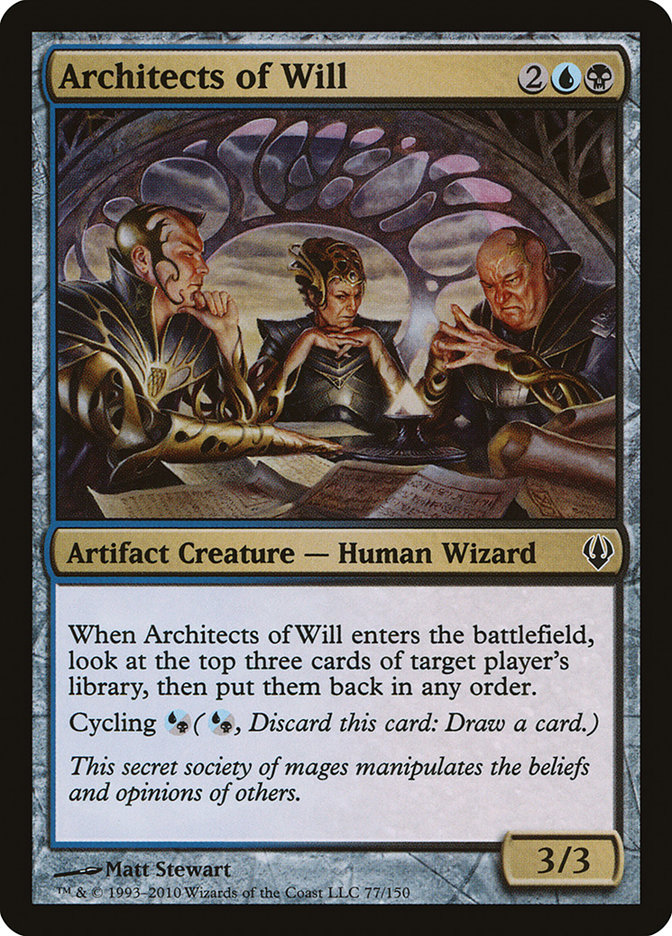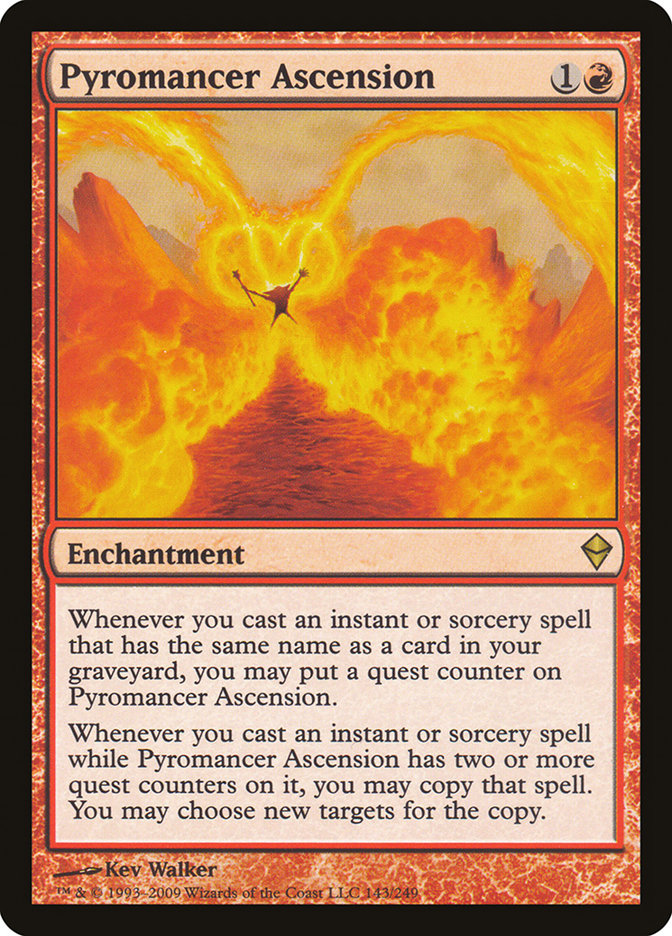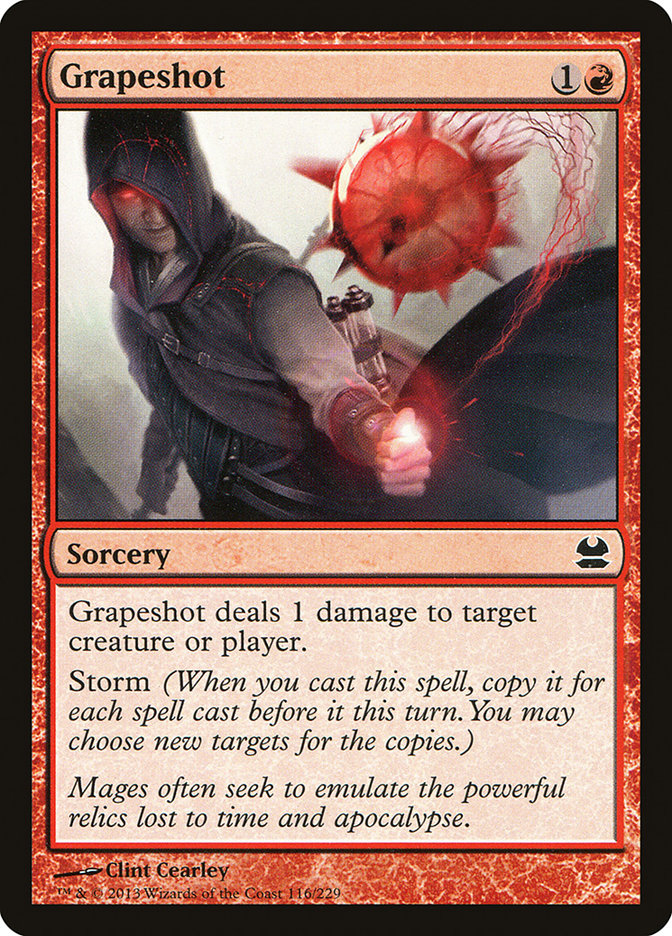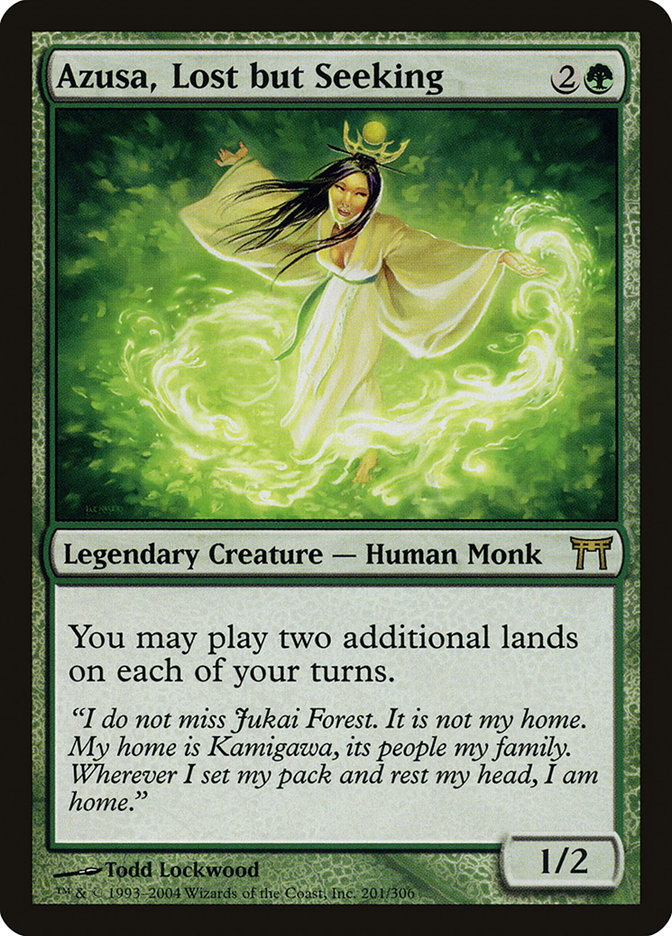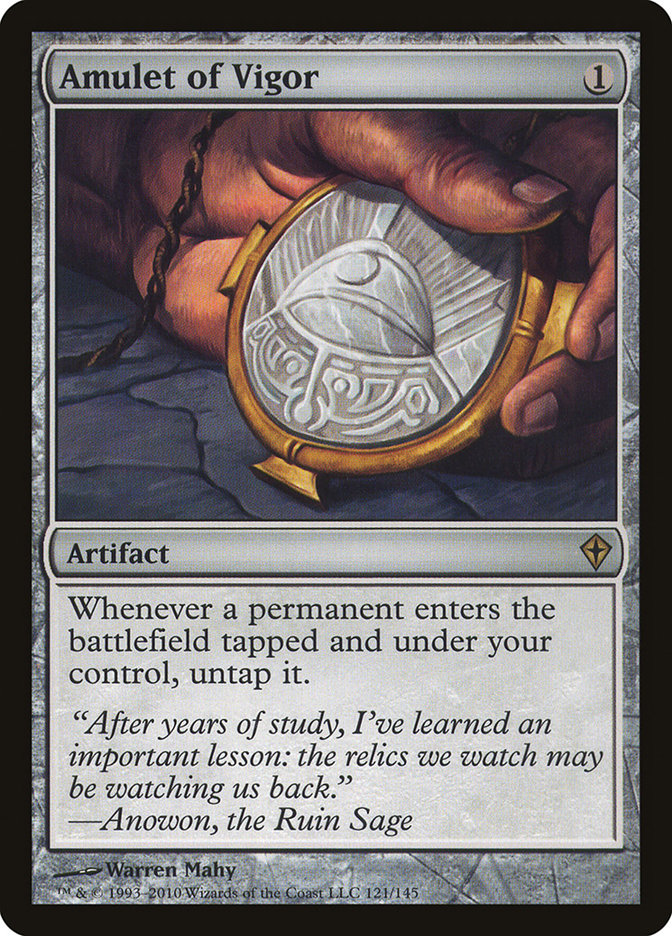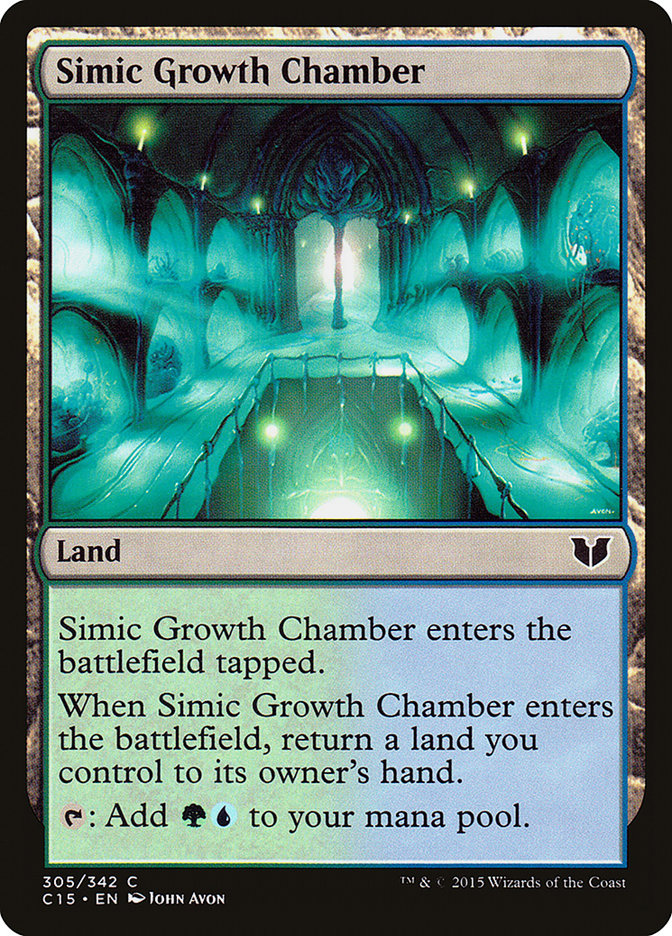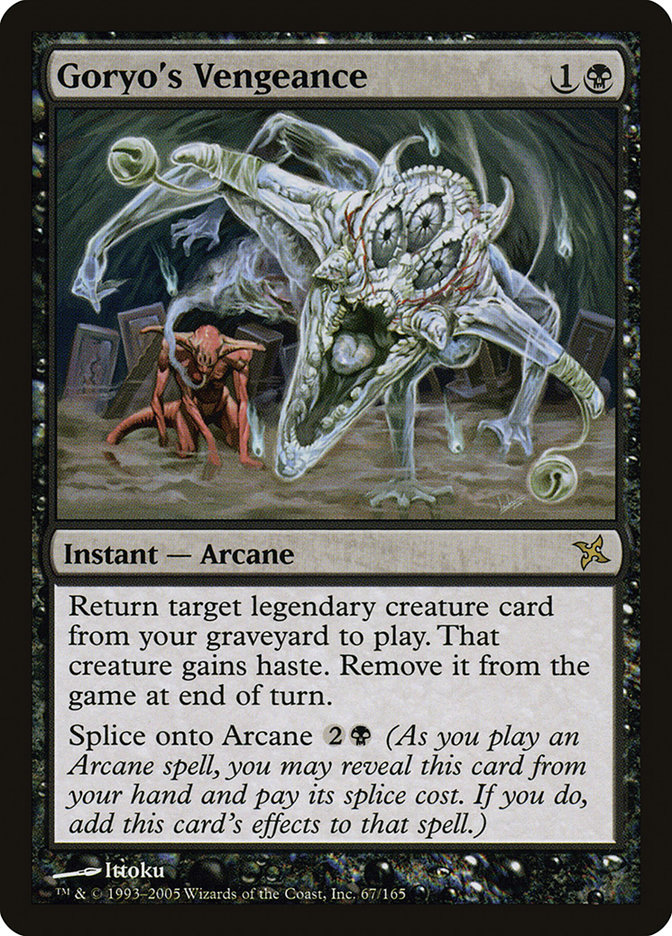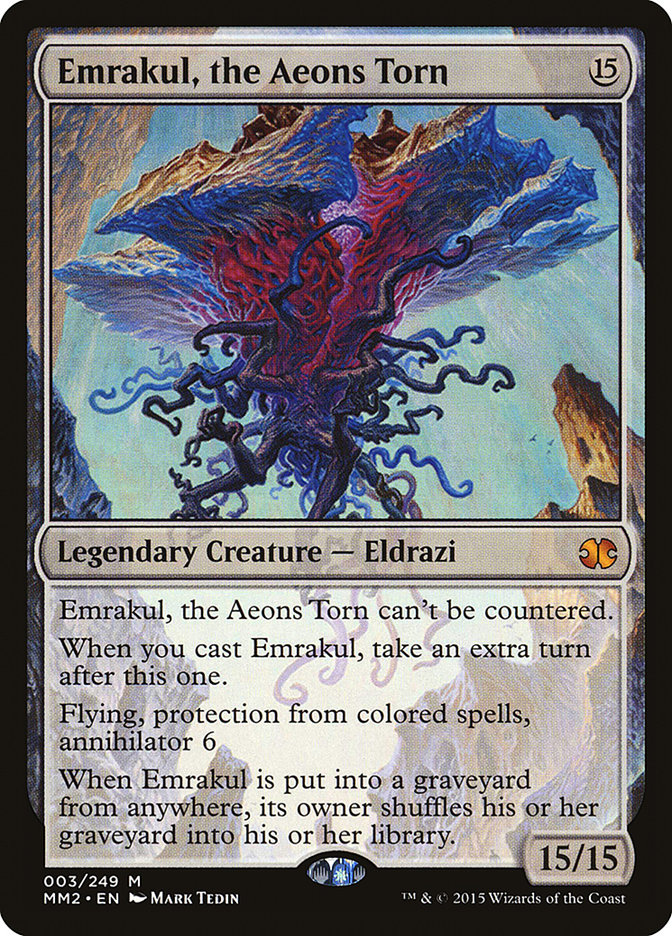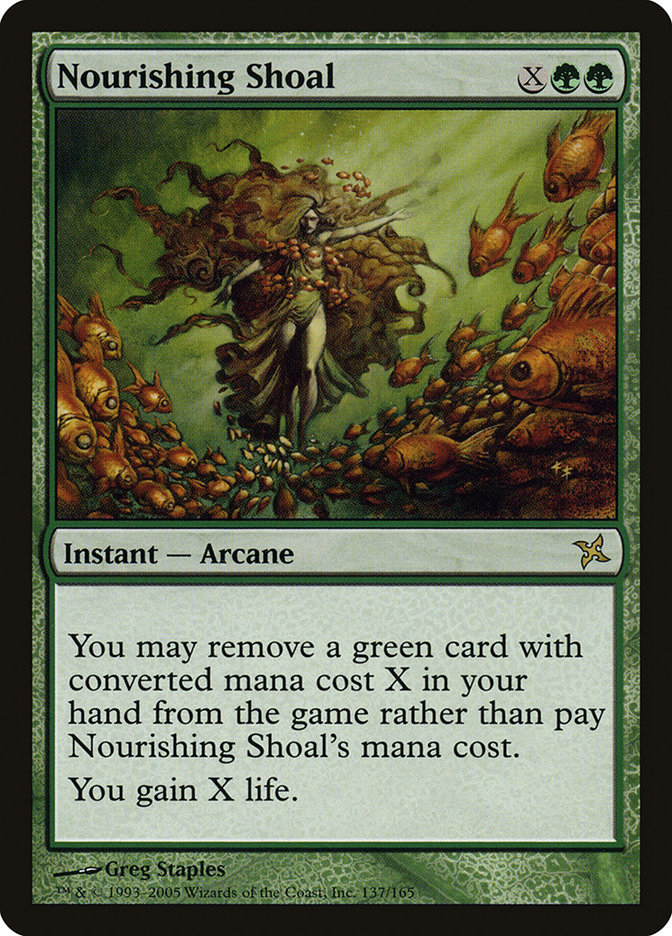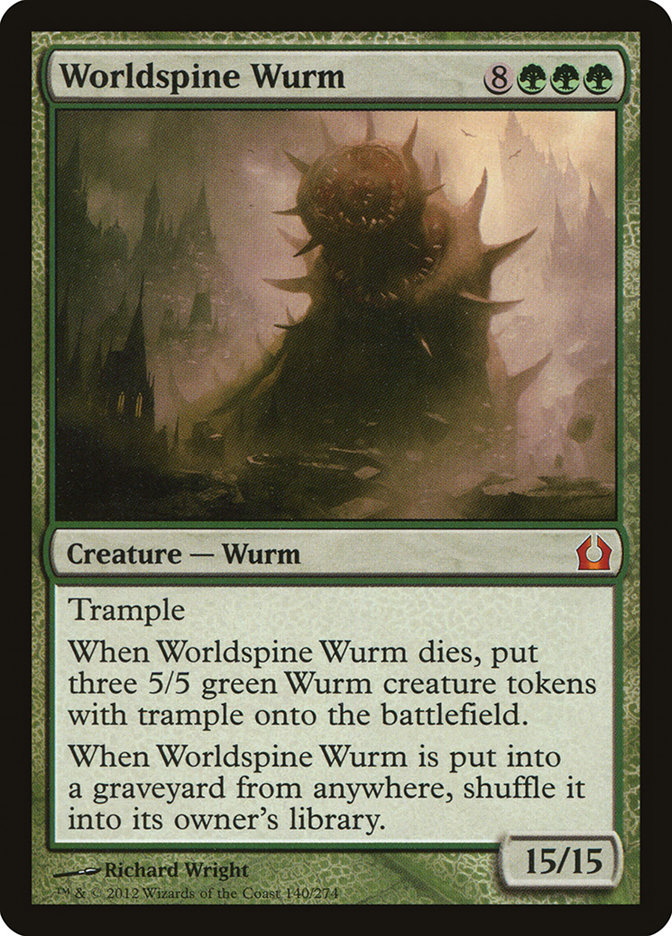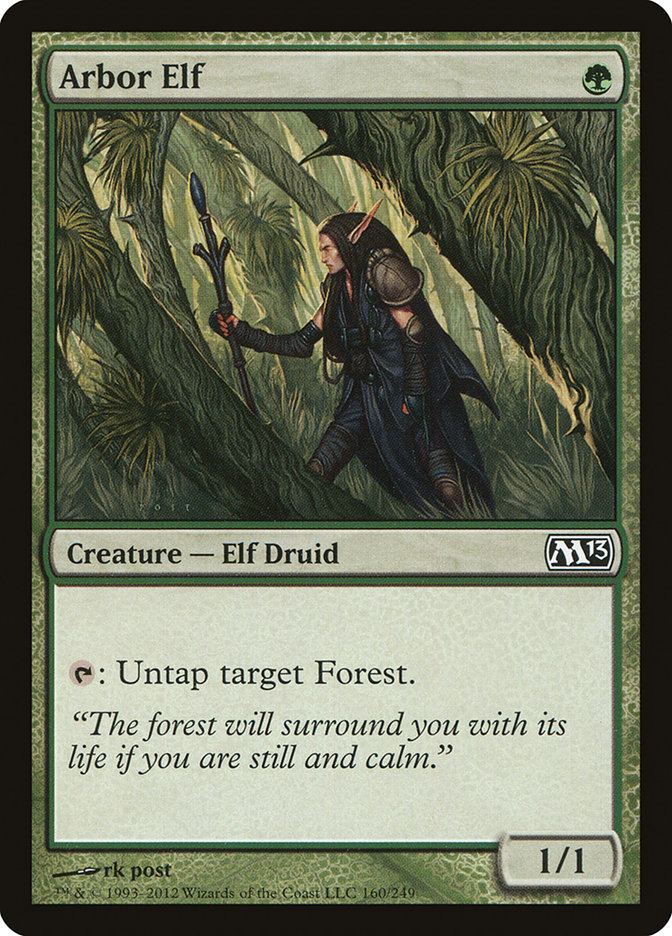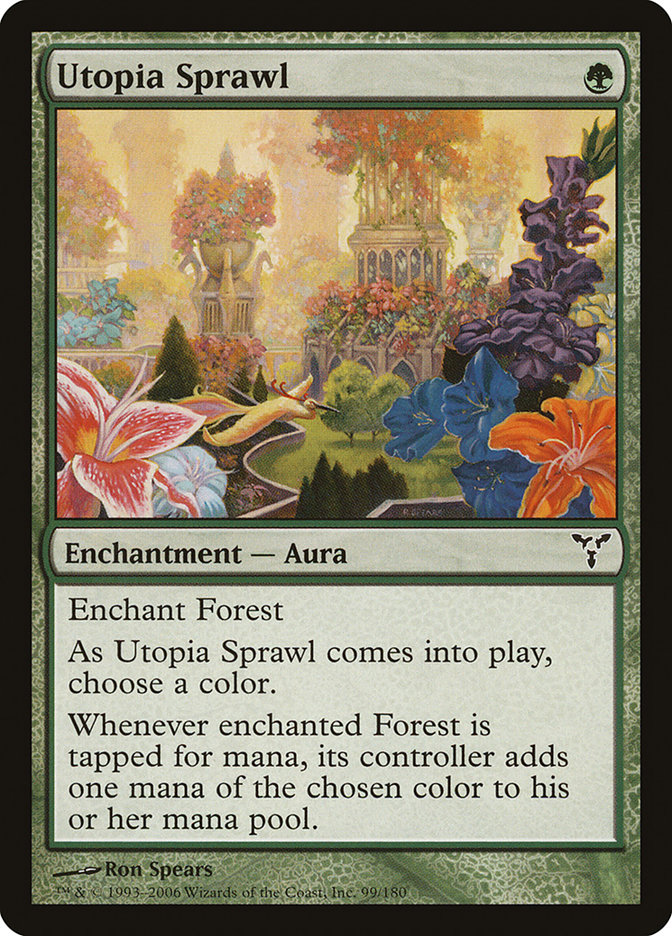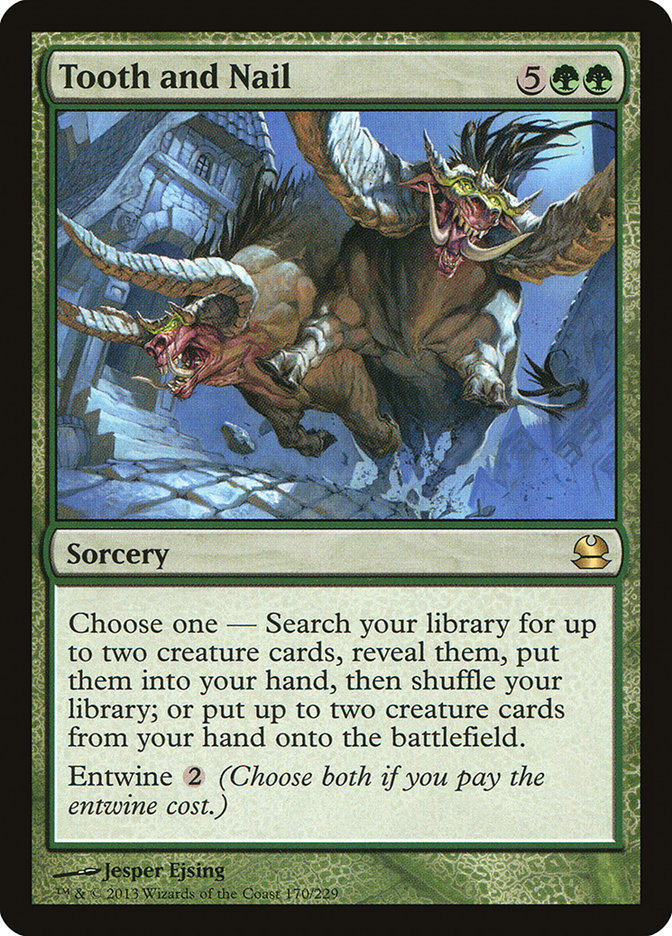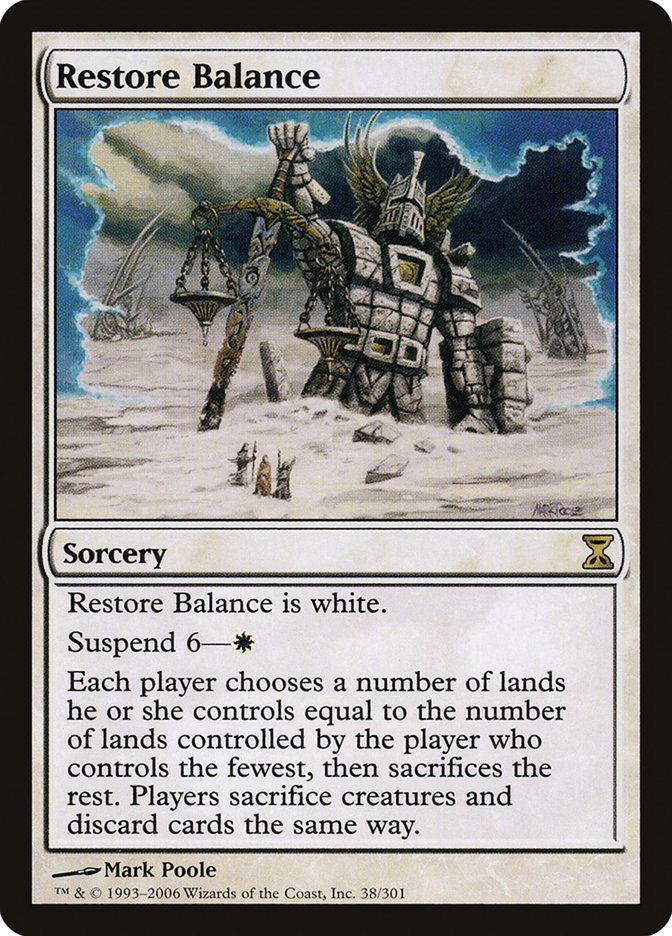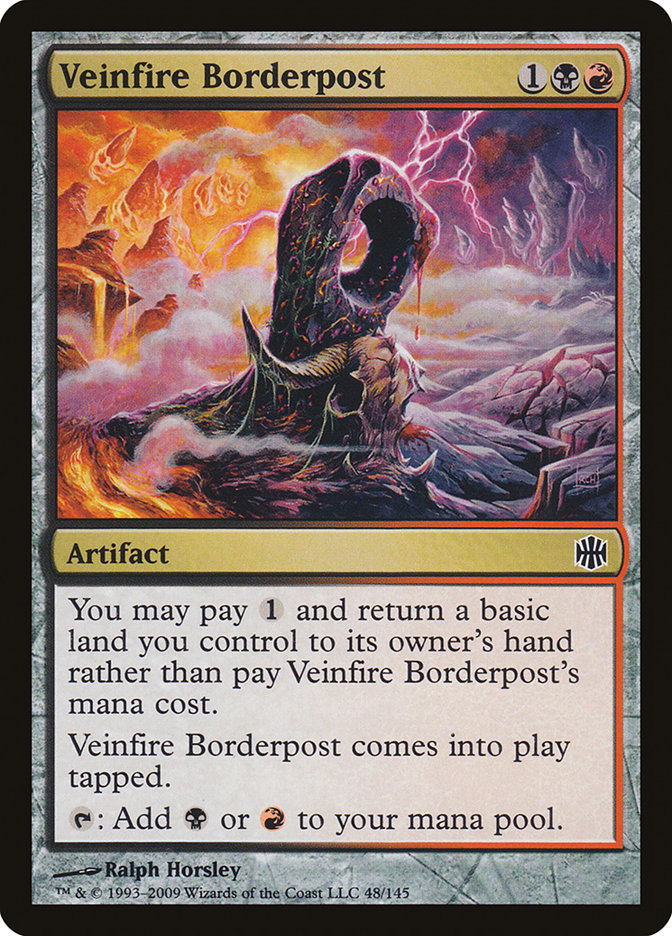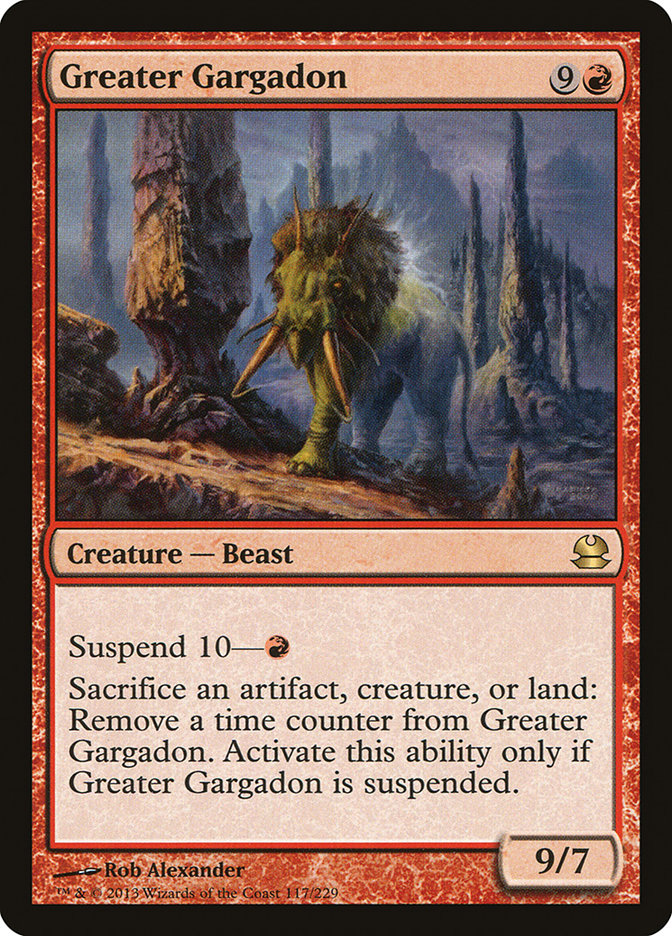Last week I began working my way through many of the combo decks you are likely to see in Modern. This week I’d like to continue so that you have a better understanding of combo decks and that they become more manageable opponents for you. The key to defeating your combo-playing friends is to understand what they are doing and to know which pieces are most important for their deck. Armed with a greater understanding, combo decks become much less intimidating.
Creatures (27)
- 3 Simian Spirit Guide
- 4 Street Wraith
- 2 Shriekmaw
- 4 Fulminator Mage
- 4 Architects of Will
- 4 Monstrous Carabid
- 2 Igneous Pouncer
- 4 Deadshot Minotaur
Lands (19)
Spells (14)
Sideboard

Named after its primary card, Living End, this deck plays cascade spells and creatures with cycling abilities.
Normally you begin the game by cycling as many large creatures as possible until you find a Violent Outburst or Demonic Dread. All cards in your library cost three or more, so the only possible spell to cascade into is Living End itself. You then clear the battlefield and return all creatures from graveyards to the battlefield, reanimating your large creatures that you had previously discarded.
Living End is not a one-turn-win combo but puts itself so far ahead on the battlefield that it is very hard to overcome. In order to stop the combo, you must counter the Living End itself. If you try to counter Violent Outburst, the original spell will be countered, but the cascade trigger will still resolve. They do have to cast the Living End, so save your countermagic for it.
Creatures (4)
Lands (16)
Spells (40)

Storm plays with the entire deck as opposed to just the cards drawn. It is unique in that, when you start to combo off, you are rarely sure that you can win. The best chance for a Storm player to win is when the opponent is tapped out or they know the path is clear of countermagic or removal. It uses cantrips and Rituals to build up lots of mana and cast enough spells in a turn to kill your opponent with Grapeshot in a single turn. It can win as early as turn 3 but usually waits a few turns more, waiting for a safe opportunity.
Any countermagic can be problematic because Storm players must be very careful with their mana on the turn the go off. Removing Pyromancer Ascension or Past in Flames can make their goal much harder to achieve. Note that countering Grapeshot will not work because the storm triggers will still resolve. Instead, the best plan I have found to stop Storm is to keep them off-balance or to try to keep them off blue mana.
Creatures (13)
- 3 Azusa, Lost but Seeking
- 1 Skyshroud Ranger
- 4 Sakura-Tribe Scout
- 1 Simian Spirit Guide
- 4 Primeval Titan
Lands (27)
Spells (20)

Azusa Amulet makes a lot of mana very quickly by playing “Karoo lands” with an Amulet of Vigor on the battlefield. This allows you to make two mana, even if the land you bounce is the one you played. The other half of the combo is Azusa, Lost but Seeking, which lets you play extra lands each turn. Once Azusa Amulet has lots of mana, it casts a Primeval Titan, tutoring for Slayers’ Stronghold and Boros Garrison on the Titan’s enters-the-battlefield trigger. Slayers’ Stronghold gives the Primeval Titan haste, fetching Sunhome, Fortress of the Legion on the attack for sixteen damage.
It can win on turn 3 or 4 and can be very hard to interact with. Stopping Amulet of Vigor will slow them down dramatically. Hold up removal for Primeval Titan because it will often be a one-turn kill when it enters the battlefield.
Creatures (12)
Lands (20)
Spells (28)

Goryo’s Vengeance is a classic case of cheating out big threats early. It plays a relatively uninteractive game, setting up its hand with cantrips and trying to get Griselbrand into the graveyard. It then casts Goryo’s Vengeance or Through the Breach to put Griselbrand on the battlefield and draw a bunch of cards. The final piece of the puzzle is to Faithless Looting away Emrakul, the Aeons Torn; respond to the shuffle trigger with another Goryo’s Vengeance; and attack for 22.
This deck can go off as early as turn 3 but is not super-consistent. The cantrip spells help to dig to the important cards but you do not always draw all of the pieces you need. You can counter Through the Breach or Goryo’s Vengeance to stop the combo, and removal on Griselbrand after they have paid life can also sometimes save you.
Creatures (14)
Lands (17)
Spells (29)

Grishoalbrand is a variant on Goryo’s Vengeance that offers more options with less consistency. It plans to cheat out an early Griselbrand and draws cards into Nourishing Shoal and Worldspine Wurm. You then exile Worldspine Wurm to Nourishing Shoal and gain eleven life to draw another fourteen cards from Griselbrand. Instead of playing Emrakul, the Aeons Torn, Grishoalbrand plays Borborygmos Enraged and will discard all the lands they drew to deal direct damage and finish the game in one turn.
Ideally Grishoalbrand will go off on turn 3. The sooner you try, the more likely you can avoid countermagic. Counter Goryo’s Vengeance or Through the Breach or else kill Griselbrand to survive. You can also threaten a burn spell so they do not feel safe going to three or less life to try to convince them not to draw their entire deck.
Creatures (16)
- 1 Birds of Paradise
- 2 Eternal Witness
- 4 Arbor Elf
- 1 Emrakul, the Aeons Torn
- 2 Obstinate Baloth
- 1 Primeval Titan
- 1 Hornet Queen
- 3 Voyaging Satyr
- 1 Xenagos, God of Revels
Planeswalkers (4)
Lands (20)
Spells (20)

Tooth and Nail ramps very quickly by enchanting lands with Utopia Sprawl and Overgrowth. You can then untap your enchanted Forests and make even more mana with Arbor Elf. Once you can make nine mana, you cast Tooth and Nail, retrieving Emrakul, the Aeons Torn and Xenagos, God of Revels, and swing for lethal.
With the right draw it is possible to have nine mana on turn 3, but you are much more likely to go off a turn or two later so you can protect your combo. Try to counter Tooth and Nail or stop them from ramping as quickly to race. Once Tooth and Nail resolves, it is very hard to survive to win the game.
Creatures (9)
Planeswalkers (6)
Lands (16)
Spells (29)

The goal of Restore Balance is to control the battlefield and cast mana rocks while keeping almost no lands before cascading into Restore Balance and removing all of your opponent’s permanents. The fewer lands or creatures you have on the battlefield and the fewer cards you have in-hand, the better Restore Balance is for you. In order to keep your card and permanent count so low, the deck runs Greater Gargadon to sacrifice permanents as soon as you have used them.
You can cascade as early as turn 3 but probably want to wait until a moment where you know you are safe from counterspells. Remember to counter the Restore Balance and not the original spell because the cascade trigger will still resolve. It also helps to have artifact removal for the mana rocks so they can’t afford to sacrifice their lands and be so far ahead.
Quasi-Combo Decks
There are other decks that are not combo decks but use a combo to gain an advantage or punch through the final points of damage.
Creatures (12)
Lands (20)
Spells (28)
- 4 Might of Old Krosa
- 1 Spell Pierce
- 4 Vines of Vastwood
- 2 Distortion Strike
- 1 Twisted Image
- 4 Mutagenic Growth
- 4 Gitaxian Probe
- 1 Dismember
- 4 Become Immense
- 3 Blossoming Defense
Sideboard

Infect plays several pump spells on one turn to hit for a lot of infect damage really quickly. It does require a combination of creatures, pump spells, and protection spells to complete its strategy, but it can win without any combo shenanigans.
Creatures (19)
Lands (17)
Spells (24)

From the old Standard deck Atarka Red, Temur Battle Rage and Become Immense have found their way to Modern. Using these two cards together can push through massive amounts of damage in a single turn, but Death’s Shadow Aggro can play an aggressive Zoo strategy without it.
Creatures (4)
Lands (18)
Spells (38)
- 4 Lightning Bolt
- 4 Serum Visions
- 4 Lightning Helix
- 3 Remand
- 4 Manamorphose
- 4 Pyromancer Ascension
- 4 Gitaxian Probe
- 4 Visions of Beyond
- 3 Faithless Looting
- 4 Thought Scour
Sideboard

Thing Ascension is similar to Storm, using Pyromancer Ascension with no storm combo finish. It still chains cantrips to try to flip Thing in the Ice quickly but does not require a combo to win in the late-game.
Creatures (29)
- 3 Llanowar Elves
- 1 Eternal Witness
- 1 Loaming Shaman
- 3 Essence Warden
- 4 Heritage Druid
- 4 Nettle Sentinel
- 4 Elvish Visionary
- 4 Arbor Elf
- 1 Ezuri, Renegade Leader
- 4 Dwynen's Elite
Lands (17)
Spells (14)

Cloudstone Curio can chain Elves for various value but normally does not win the game on its own. Generally the Elves swarm the battlefield and win a turn later with Overrun tactics.
Creatures (30)
- 4 Birds of Paradise
- 1 Kiki-Jiki, Mirror Breaker
- 3 Eternal Witness
- 3 Wall of Roots
- 1 Orzhov Pontiff
- 1 Reveillark
- 1 Lone Missionary
- 3 Wall of Omens
- 1 Scavenging Ooze
- 4 Restoration Angel
- 1 Thragtusk
- 4 Voice of Resurgence
- 1 Reclamation Sage
- 1 Siege Rhino
- 1 Pia and Kiran Nalaar
Lands (22)
Spells (8)

Built on Kiki-Jiki, Mirror Breaker and Restoration Angel, Kiki Chord can win with an infinite combo of hasty Angels but generally can win with a value based strategy. When every card you play gains you extra value, you are in a good position to win without needing to rely in a combo finish.
Lands (18)
Spells (42)

Lantern Control is a prison lock strategy powered by a combination of Lantern of Insight, Ghoulcaller’s Bell, Codex Shredder, and Ensnaring Bridge. The combo does not win the game but rather locks the opponent out so there is no way to stop inevitable milling.
Creatures (6)
Planeswalkers (4)
Lands (24)
Spells (26)

Several decks have begun to include Nahiri, the Harbinger as a combo win condition. All you need to do is tick up Nahiri and then tutor a single copy of Emrakul, the Aeons Torn. This combo is often found in control decks but is rarely the only win condition.
Conclusion
When it comes to combo decks, knowing is half of the battle. Once you know how each combo deck works and its weak points, it becomes much easier to defeat. There will always be new combo decks trying to make their mark on Modern, but I hope that you have found this helpful to know many of them much better. May your knowledge of combos lead you to victory, either by piloting your favorite or by knowing how to stop them. Have a wonderful week, and as always, happy gaming!


